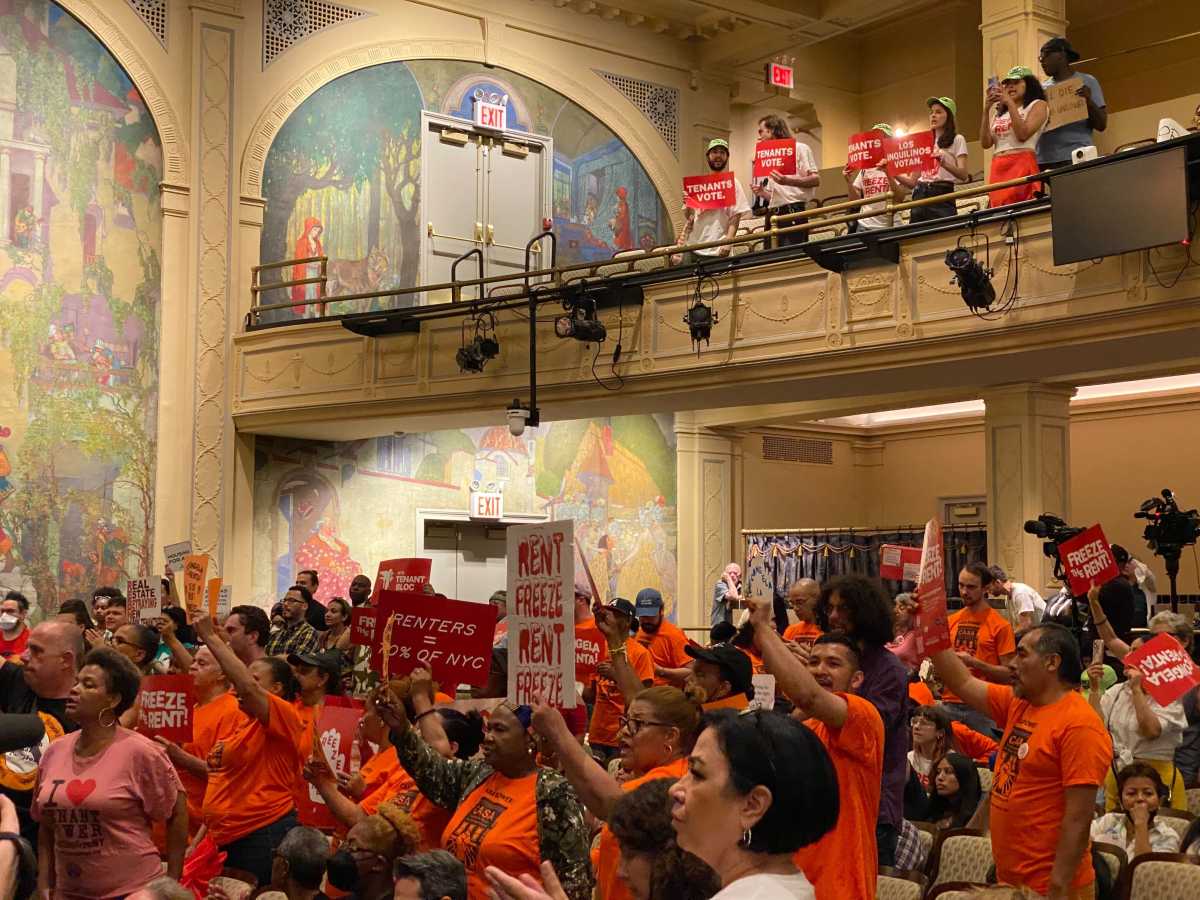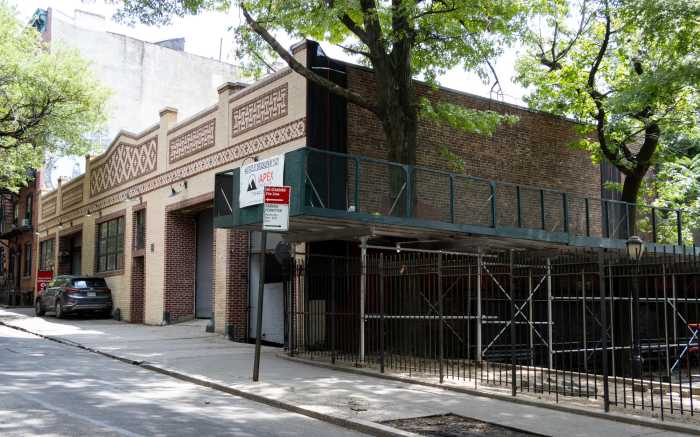Borough President Marty Markowitz gave his approval this week to the controversial
Downtown Brooklyn Plan, a city proposal that would use the state’s
power of eminent domain to condemn private property and rezone the area
to allow for taller buildings. The Downtown Plan’s advocates say
they envision a 24-7 commercial and residential hub with skyscraping office
and residential towers. The plan overlaps, but is separate from, developer
Bruce Ratner’s Atlantic Yards project that could include a professional
basketball arena as well as office towers and housing.
Along with his thumbs-up, Markowitz delivered a laundry list of conditions
he would like to see attached to the Department of City Planning proposal,
addressing everything from traffic to preservation to affordable housing
concerns.
“I believe we can grow and maintain our uniqueness. I don’t
believe they have to be mutually exclusive,” Markowitz told reporters
Wednesday as he released his recommendation. He stressed the importance
of what he called “smart development” in the Downtown Plan.
The Downtown Brooklyn Plan would allow for the construction of at least
6.7 million square feet of office space, 1 million square feet of retail,
1,000 units of housing and 2,500 parking spaces.
As part of the plan the city intends to condemn seven acres of private
property including 130 residential units and 100 businesses in the downtown
area.
Among their ranks are a college of architecture and a clothing store,
both of which Markowitz is asking the city spare.
The Institute of Design and Construction, a 57-year-old college on Willoughby
Street at Flatbush Avenue Extension, is slated to be among the first properties
to go.
“I believe they can move ahead and let the institute stay,”
said Markowitz.
Under the plan as it currently reads, the four-story building would be
razed to create open space to afford better site-lines from Flatbush Avenue
to a 1.5-acre open space over an underground garage.
The college’s president, Vincent Battista, a vocal opponent of the
plan, has testified at several public hearings and pleaded his case to
the borough president.
So has Joe Betesh, the owner of Brooklyn USA, a two-story 25,000-square-foot
jeans and sneakers store at 245 Duffield St., just off Fulton Mall. At
a five-hour pubic hearing at Borough Hall on Feb. 18, Betesh asked Markowitz
to reject the plan.
Those pleadings have apparently paid off, at least to the extent that
Markowitz’s recommendations are considered by the City Planning Commission,
the next reviewing authority in the city’s Uniform Land Use Review
Procedure, which will also put the application before the City Council.
The City Planning Commission will hold a public hearing at 10 am on March
24, in the Klitgord Auditorium at New York City College of Technology,
285 Jay St., Downtown.
Community Board 2 failed to make a recommendation when the complex proposal
came before it last month.
In his recommendations, Markowitz calls on the city to work closely with
the owner of Brooklyn USA to find an equivalent location nearby.
In the course of exercising its right of eminent domain to condemn properties
for public benefit the city is required to hire an independent appraiser
to determine the market value of a property, according to a spokeswoman
for the city Department of Housing Preservation and Development, the agency
that would be involved in assisting business and residential property
owners in relocating. Market value is generally lower, however, than what
brokers often term fair market value, which tends to be a truer indicator
of what a property can bring on the open market.
The spokeswoman, Carol Abrams, said businesses that lease space would
be assisted by the agency and that the Economic Development Corporation
would also work with displaced commercial tenants to find “suitable
new commercial space in the area.”
As far as residential renters, Abrams said, “Every effort is made
to refer tenants to apartments that are in the immediate neighborhood
or in other areas that the tenant prefers. In addition, the residential
tenant will be entitled to moving expenses, replacement housing payments
or may qualify for a down-payment assistance payment.”
As for the college, the borough president suggests redirecting money to
be used for acquiring and condemning the school to rehabilitate neighborhood
parks.
Asked why Brooklyn USA was singled out for assistance, Richard Bearak,
the borough president’s deputy director of planning and development,
noted that the business was “vocal” and “used the process.”
Bearak urged other businesses with concerns to do the same.
Markowitz also urged planners to turn down 40 year extensions of the durations
of the Atlantic Terminal and Metrotech Urban Renewal areas. The two designations
allow for the condemnation of private property in those areas.
This week, even some critics of the plan lauded Markowitz’s recommendations.
“We, as part of a coalition of Downtown Brooklyn neighborhoods, are
very pleased with the recommendation,” said Sue Wolfe, president
of the Boerum Hill Association. “It is very well thought-out and
we see a lot of the things we asked for in it.”
That sentiment was echoed by Carolyn Konheim, president of Community Consulting
Services (CCS), a firm specializing in traffic patterns.
Traffic and transportation
Traffic issues related to the Downtown Plan have been a concern of residents
in and around the area since the plan was first announced.
More than 17,000 extra cars, 95,000 additional subway riders and 21,000
more bus riders are expected to be drawn to the area, according to CCS,
traffic has been a major concern. Community Board 2 generated a lengthy
list of traffic and transportation concerns, some of which were picked
up by the borough president.
In addition to recommending the creation of a special Transportation Management
Association to address traffic, parking and mass transportation needs,
Markowitz is calling for:
•A jitney loop through Downtown Brooklyn linking to Fulton Ferry
Landing.
•Ferry service connecting to Manhattan, Staten Island and New Jersey.
•Residential parking permits in surrounding neighborhoods like Brooklyn
Heights.
•Midday service through Downtown Brooklyn on the 5 subway line.
•Free MetroCard surface transfers between Downtown Brooklyn subway
stations.
•Reducing the number of on-street governmental permit-parking spots
and encouraging Metrotech businesses to lease unused parking spaces to
city agencies.
•Replacing individual parking meters with muni-meters in downtown,
Brooklyn Heights, Boerum Hill and adjacent sections of Fort Greene.
•Providing adequate parking space for bicycles.
‘Affordable’ housing
With 1,000 units of housing projected in the plan, Markowitz stipulated
that at least 20 percent should be reserved as “affordable to Brooklyn
residents.”
He also called for residents within the confines of CB2 to get priority
for half of those, or approximately 100 units.
Markowitz also re-emphasized a point already agreed upon — that 10
percent of the proceeds from the sale of the old Board of Education headquarters
at 110 Livingston St. to developer David Walentas, who will convert them
into condominiums, go towards creating affordable housing downtown. The
city agreed to sell the building to Walentas for $45 million last July.
In addition to creating new programs, Markowitz cast an eye on preserving
old ones:
•Maintain the facade of 131 Livingston St., a beaux-arts building
that the former Board of Education had used for office space.
•Place a historical marker to commemorate Red Hook Lane, which runs
for a one-block stretch between Livingston Street and Fulton Mall, and
which would be de-mapped to make way for a new building.
•Relocate the buildings at 227, 231, 233 and 235 Duffield St. and
436 Albee Square West to nearby properties.
•Salvage architecturally significant facade ornaments of the Jacobs
Building at Polytechnic University, at Tech Place and Jay Street, at developers’
expense.
•Remove 522 and 526 Fulton St. from the plan. Owners of the property
had previously agreed to develop the site as classrooms for Long Island
University, but placed the project on hold when they received a letter
about the Downtown Brooklyn Plan from the city.
“The conditions that I’ve set will make this plan work for Brooklyn,”
Markowitz said Wednesday.
But some critics still have their doubts.
Brian Ketcham, executive director of Community Consulting Services, believes
the city needs to put the project on hold and fully study the traffic
implications.
Because the draft environmental impact statement on the plan did not take
into account the proposed Atlantic Yards basketball arena and office and
residential tower development, planners are currently putting together
a supplemental EIS.
That document is still being culled and was not available for Markowitz
before he reviewed the plan.
At the same time, Battista, who owns the college on Willoughby Street,
says he is not counting his chickens yet.
“I’m happy that he is making that recommendation, but what does
that actually mean?” Battista said. “The thing is that this
is only a recommendation. When I see that written in stone than I’ll
start to breathe a sigh of relief.

























